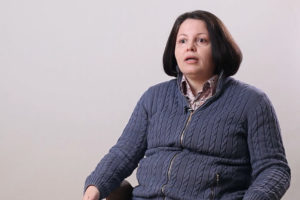Ethics of Machines
Philosopher David Edmonds on relationship between moral philosophy and robotics, artificial intelligence and e...
At the School of Advanced Studies in Tyumen, for the last two years, I’ve been working as part of the ‘Material Relations’ team. The idea behind this team starts with the problem that there’s something fundamentally wrong, there’s something destructive, and there’s something unsustainable about human relations with the material world. I think this is a truism: we know this: we’re in a time of ecological crisis; we’re in an age of mass consumption and waste and environmental disaster. So the idea is that maybe it’s not just the practices that are wrong; it’s not just that we’re consuming too many fossil fuels or producing too much plastic. We say that the problem actually our orientation to matter itself: we need a new idea about the relationship between humans and materials to change practices. You can’t change practices alone; you have to change the ideas behind the practices.
My role in ‘Material relations’, in our attempt to rethink this relationship between humans and materials, has been a historical one: to go back a thousand years into the medieval Western past and to try and uncover some relationships between humans and materials that might challenge our relationships in the present. In other words, I’m trying to find some paths not taken in the past, some ways of thinking about the material world. I’m not saying it’s going to be directly useful in the present, but it might jolt us, might shock us, might act as some kind of paradigm that might help our thoughts today.
On the other hand, medieval Christianity was extremely obsessed with the material world. Material things can be highly productive in devotional exercise. Relics are extremely popular: people come from all over Europe to see the shrine of Thomas Becket, to take his blood relic with them and wear it on a wire around their neck because the physicality of that blood will have some power for them. Stained glass windows produce a spectacular effect on one’s devotion. There are miracles that involve objects all the time: saints move things around, and they make water bubble up. The material world, in other words, can be infused with miraculous power but can also be a bridge to some kind of higher understanding: through objects, you might understand something that you can’t do just by thinking alone.
Of course, the Eucharist wafer is the high culmination of that. Just after 1200, there was this new enthusiasm for communion, and there’s this idea which finally began formally in 1215 that when you eat the wafer in the Eucharist, you’re not just eating a representation of the body of Christ: you are really eating the body of Christ, you’re ingesting that body. The body itself, matter, plays a much more important role there.
Equally, there’s this obsession with your own body, that your body is not just something to be overcome but it’s an instrument of your salvation, and it will be there at the time of your resurrection: all of your fingernails will come back at the time of ascension to paradise, all of your hair will come back, all of it matters. All of the stuff of your body is part of you; it matters, and it’s not something to be forgotten.
Relics have often been seen as just symbols: a lot of historians write about them as if they’re just functional. A church will own a relic because it’s a symbol of its institutional prestige and legitimacy; people will own relics almost as commodities. Yes, people pray to relics, and there’s a sense that they are imbued with the power, but it’s also symbolic. But here, with Hugh attempting to eat the relic, it’s like there’s something that cannot be obtained just by contact, some power in the relic that cannot be obtained just by looking at it or thinking about it or being in its presence: you need to actually ingest it.
I think what Hugh is drawing attention to is that inscrutable, irreducible, unobtainable power that the object has, its essence, which is beyond our reach. Graham Harmon, the philosopher of object-oriented ontology, writes about a third object.
We can reduce an object just down to matter particles, to its chemical components. Another reduction for Harmon is when we reduce an object to its effects: what does it do for people in the world.
In this sense, the relic performs a kind of power. Harmon says there’s another object, and it’s a gap between these two. I feel that for Hugh of Lincoln, when he’s trying to eat this bone, he’s trying to access that other relic, that relic that’s more than just a symbol, more than just an object, a bone: it’s something else, it has its own power and essence that we as humans cannot access.
It’s interesting because Hugh is doing this at a time when relics are more popular than ever. In many ways, I see him as kind of rebelling against the people who’ve just used relics as commodities. In other ways, I see him as participating in a deeply sceptical movement: there were people who were deeply sceptical about objects as symbols. There’s a group of heretics called the Petrobrusians that say they don’t want any crucifixes; they suggest burning all of the crucifixes because we shouldn’t be worshipping an object; we should just think about Christ; we should burn all the churches; we don’t need churches because we don’t need the object of the church, we just need our ideas. These guys are seen as very, very extreme heretics. Peter of Bruys, the founder of this tradition, ends up getting pushed into a fire and burnt because there’s so much outcry at this. Now, with Hugh of Lincoln, even though he’s seemingly nothing like this, he wants the object, I feel like he’s part of that sceptical movement because it’s saying the symbol is not enough, it’s not truly powerful. I think the Petrobrusians are extreme; they don’t want any symbols, but maybe Hugh is part of that movement because he wants a real object; he doesn’t want symbols.
A second object that I focused on, or maybe not really an object but a material substance, is fire. There’s a long discourse in the medieval world about fire as having its own power: it’s a power of purifying things, so fire can purify you. Heretics are burnt because we need to purify this corrupt body of the heretics. People had trial by fire: if you’re accused of something which you cannot prove you didn’t do, sometimes you’re forced to walk through fire to prove that you’re innocent. The fire will purify you; the fire will test you.
There’s a fascinating encounter. Francis of Assisi, the 13th-century saint, talks about fire in a very strange way. There’s this moment where Francis is sitting at a fire with his brothers, and his trousers catch fire. The other brothers say, ‘This is terrible; put the fire out! Put the fire out!’. And Francis says, ‘No’. He’s burning, but he says, ‘No, leave it; do not get in the way of what brother fire wants’. It’s an absurd moment. Is it a joke? Good question.
I think Francis is suggesting there that fire has its own will, its own desire. Maybe he’s suggesting it as a joke but I believe the joke still expresses some kind of truth, the joke expresses something.
What does Francis mean by fire having its own will? It seems absurd, but if we actually dig into 13th-century texts and ideas and theologians and academics, we start to see that there is intellectual support for this idea that fire itself has a will or its own reason. On the one hand, scholars such as Robert Grosseteste, a follower of Francis in many ways, write about fire as being the element which is contained in all things: it is the substance which is present everywhere. In our eyes, in all of our physicality, there is a fire somewhere, a small spark. More than that, for Grosseteste, fire is the substance of heaven itself; the celestial sphere is a fiery sphere. So, on the one hand, fire has a will because it is the essence of being; on the other hand, another scholar also, by chance, a follower of St. Francis, Bonaventure, writes about substances like fire as having a will of their own. For Bonaventure, will and matter complete each other, so the physical world and the non-physical world complete each other. The physical world is not just a support for the non-corporeal world; the body is not just a support for the soul: they are reciprocal; they need one another to complete one another. Bonaventure says that just as reason is a mental process, then matter also has its own reason: just as the mind desires its completion in the physical world, the physical world also desires its completion in the non-corporeal world.
Later, Marguerite Porete, who was a mystic in the early 14th century, writes about the human and fire as being indistinguishable: when you are so in love with God, you burn as if you were a fire, you almost become that fire of God. It’s like you’ve reached that celestial sphere of fire that Bonaventure talks about, and your desires then are in conjunction with a physical world’s desire; your soul’s desire, the completion with God, is in conjunction with or is blended with some mysterious desire of the physical world.
What does all of this mean for present-day material relations? I think that we could see these extraordinary examples as paradigms for thinking about the matter, or maybe they can just be ways of shocking us into remembering that we’re not limited to an instrumental or a reductive view of the material world. Maybe if we think, as medieval people did, that there is some reason, desire, will, and love even in material things, this can help us think about our ethical responsibilities towards them differently. If we also remember (like Hugh of Lincoln did) that there is something, there’s an essence in matter which we cannot grasp, that is always beyond us, it might help us to think more benevolently or to have more respect for materials.

Philosopher David Edmonds on relationship between moral philosophy and robotics, artificial intelligence and e...

Media Scientist Renira Rampazzo Gambarato on three different types of transmedia stories, ‘The Matrix’ and why...

Philosopher and sociologist of science Steve Fuller on the peer-review process, the relationship between scien...